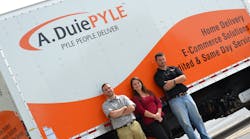Over the past three years, LTL, truckload and logistics provider A. Duie Pyle has improved its work-related injury rate by 52% and accident rate by 23%. According to Pete Dannecker, vice president of risk and integrated resources, those improvements are driven by the company’s employees.
“The long-term trend continues to be toward improvement,” Dannecker told Fleet Owner. “What we do relative to safety is we weave that into the fabric of the business. That is what we want to accomplish. We want a self-sustaining safety culture that’s driven by the employees. We want organizational alignment. We want everyone knowing their job is contributing toward the greater success of the business.”
Here’s a look at some of the safety practices Pyle has put into place to help keep its work-related injuries and crash rates down.
Acting on employee suggestions
In order to weave the right safety elements into its overall business operations, Dannecker said it really starts with open communication and listening to and acting on employee recommendations.
For example, drivers told management they found it difficult at night to back into an LTL dock or a warehouse facility when the yard lights were positioned on the perimeter. That placement, Dannecker noted, is optimal lighting for people walking around, but the lights end up blinding the drivers. What Pyle figured out based on drivers’ suggestions is that it is best to balance out the light at the rear of the truck so they have better visibility. Now, the company adds a bright LED light between the trailers up against the docks so drivers can see where their wheels are relative to what they’re backing into.
“It sounds simple, but I didn’t think of it,” Dannecker said. “It was a driver suggestion that got us there.”
Based on another employee suggestion, every year Pyle now freshens up the paint job of its terminal facilities to better assist drivers when they’re backing in their trailers. Though it’s typically a minor problem to bump another trailer, Dannecker stressed it can still cause damage, and that costs money.
“[An accident] still take away from what we’re doing,” he explained. “It takes time. So we add glass beads to the paint, so the paint is reflective. We didn’t used to do that. We used to use just whatever paint we could find. This costs more, this takes longer, but the return we get is drivers know they’re valued and listened to, there are fewer accidents, and we believe there’s a payout.”
And when there is an accident or someone is injured on the job, Dannecker said Pyle conducts a root-cause investigation to determine what could have been done differently. But over time, the company has learned how to better prevent those types of work-related injuries. For instance, at one of its facilities, heavier tools were mounted over a workbench and arranged in a way that management considered efficient, but one fleet technician pointed out that because he is shorter, he had to lean over the bench at an awkward angle and was at risk of being injured when he needed a tool. After making the suggestion, the company moved the tools to a safer, more convenient location for all its technicians.
“It might’ve put this employee at risk, so we moved it,” Dannecker said. “It’s those small things. Listening to the employees and providing the mechanism to help the changes be put in place that I think pushes us in the direction we want to go.”
Training
When new drivers start at Pyle, Dannecker said they spend nearly a week in the classroom even if they’re already experienced. They spend time discussing the company and their roles within the company, what their expectations are, and how to properly perform pre- and post-trips.
“The expectation is a professional driver with experience knows how to do that, and they may,” Dannecker explained. “But we just want to ensure they’re set up for success and we show them how to do it. They also go out in the truck with another driver typically for 2-5 days and learn how to work with our communication systems so that they’re not distracting when they’re driving.”
Pyle noted it also trains drivers on progressive shifting, which could help reduce overall fuel costs. Though the majority of the fleet’s trucks going forward will be spec’d with automated manual transmissions (AMTs), the company still relies on many of its trucks that are equipped with manual transmissions, Dannecker explained. He added that Pyle also incorporates a defensive driving program to train its drivers.
“When we do that and we teach the shifting pattern, we’re teaching the drivers to manage the space around their vehicle and drive very smoothly,” Dannecker stressed. “The benefits of that are improved fuel mileage and less wear and tear on the vehicle, which makes our shop more efficient, and the drivers take pride in what they’re doing.”
Spec’ing for safety
When it comes to implementing safety technologies, Pyle is now spec’ing its trucks with collision mitigation systems that detect hard-braking events. So if there is a hard-brake event – if a vehicle slows down quickly, 9 miles per hour or more in a second – the system will trigger a recording for 7-9 seconds before and after the event. The system will also detect if a driver changes lanes without signaling or if the truck veers suddenly. Dannecker added that most of the fleet’s trucks are equipped with anti-rollover technology and anti-jackknife technology that sends messages and a forward-looking camera view back to management.
As he mentioned before, Pyle is also spec’ing equipment with AMTs, which Dannecker said saves fuel over time and puts less wear and tear on the driver. With AMTs, drivers aren’t pushing the clutch pedal, which can lead to knee injuries over time, he stressed.
Drivers also could be susceptible to injuries when they’re dropping a trailer and they have to reach underneath the trailer at the fifth wheel and pull out a lever to disengage the fifth wheel from the trailer pin. That awkward reach could lead to rotator cuff injuries, so Dannecker said Pyle has invested in a button on the dashboard of its tractors, which is an air-release fifth wheel in which drivers push a button and the jaws snap open. Drivers no longer have to reach under the trailer and risk getting dirty or tearing their rotator cuff. Since Pyle invested in those buttons, Dannecker said the company has not had a rotator cuff injury or tear.
And when it comes to making more improvements going forward, Dannecker said it isn’t just about safety. “We are trying to improve in everything all the time,” he stressed. “It’s an absolute commitment to continual improvement.”





